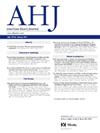在一项大型随机临床试验中确定高风险入组标准及其对临床结果的影响:来自TWILIGHT试验的见解
IF 3.7
2区 医学
Q1 CARDIAC & CARDIOVASCULAR SYSTEMS
引用次数: 0
摘要
研究背景TWILIGHT试验显示,在接受经皮冠状动脉介入治疗(PCI)并在3个月内无事件发生的高危患者中,替卡格雷单药治疗与替卡格雷加阿司匹林治疗可减少出血而不增加缺血性事件:这项事后分析描述了 TWILIGHT 试验入组患者的风险概况和结果。主要结果是出血学术研究联合会(BARC)2、3或5型出血,关键的次要结果是随机化后一年内死亡、心肌梗死或中风的复合结果:符合≤3、4、5或≥6个危险因素的患者(人数=7119)比例分别为21.5%、32.7%、27.4%和18.4%。肌钙蛋白阳性的急性冠脉综合征(ACS)是最常见的临床标准(64.9%),多血管疾病(MVD)是最常见的血管造影标准(66.5%)。最常见的交叉标准是肌钙蛋白阳性 ACS、动脉粥样硬化性血管疾病、MVD、左主干或前降支近端病变以及支架长度大于 30 毫米的组合。随着高危标准数量的增加,缺血风险逐步增加,但出血风险并未增加。与替卡格雷加阿司匹林相比,无论风险因素的数量如何,替卡格雷单药治疗都能减少出血(≤3-RF:3.5% vs. 5.8%,HR 0.59,95% CI [0.38-0.93];4-RF:3.5% vs. 5.8%,HR 0.59,95% CI [0.38-0.93])。38-0.93];4-RF:3.7% vs. 6.4%,HR 0.57,95% CI [0.37-0.86];5-RF:3.8% vs. 8.6%,HR 0.44,95% CI [0.29-0.66];≥6-RF:5.3% vs. 7.9%,HR 0.65,95% CI [0.44-0.96];p-交互作用=0.56),而不会显著增加缺血风险(≤3-RF:1.6% vs. 2.1%,HR 0.75,95% CI [0.38-1.50];4-RF:3.5% vs. 2.2%,HR 1.58,95% CI [0.91-2.75];5-RF:4.1% vs. 5.0%,HR 0.80,95% CI [0.51-1.24];≥6-RF:6.7% vs. 6.9%,HR 0.98,95% CI [0.67-1.43];P-交互作用=0.22).结论:在 TWILIGHT 试验中,高危特征与缺血风险的相关性比与出血风险的相关性更强。尽管如此,与替卡格雷加阿司匹林相比,无论高危特征有多少,替卡格雷的获益都是一致的。这些发现仅适用于PCI术后3个月无事件发生的患者:该试验已在ClinicalTrials.gov注册,编号为NCT02270242。本文章由计算机程序翻译,如有差异,请以英文原文为准。
Characterizing high-risk enrollment criteria and impact on clinical outcomes in a large randomized clinical trial: Insights from the TWILIGHT trial
Background
The TWILIGHT trial showed that, among high-risk patients who underwent percutaneous coronary intervention (PCI) and were event-free at 3 months, ticagrelor monotherapy versus ticagrelor plus aspirin reduced bleeding without increasing ischemic events.
Methods
This posthoc analysis describes the risk profiles and outcomes of patients enrolled in the TWILIGHT trial. The primary outcome was Bleeding Academic Research Consortium (BARC) type 2, 3, or 5 bleeding, and the key secondary outcome was a composite of death, myocardial infarction, or stroke within 1 year after randomization.
Results
The proportion of patients (n = 7,119) fulfilling ≤ 3, 4, 5, or ≥ 6 risk factors was 21.5%, 32.7%, 27.4%, and 18.4%, respectively. Troponin-positive acute coronary syndrome (ACS) was the most prevalent clinical criterion (64.9%), and multivessel disease (MVD) was the most prevalent angiographic criterion (66.5%). The most frequent intersection of criteria was the combination of troponin-positive ACS, atherosclerotic vascular disease, MVD, left main or proximal anterior descending lesion, and stent length > 30 mm. A stepwise increase in ischemic but not in bleeding risk was noted with an increasing number of high-risk criteria. Compared with ticagrelor plus aspirin, ticagrelor monotherapy reduced bleeding regardless of the number of risk factors (≤ 3-RF: 3.5% vs 5.8%, HR 0.59, 95% CI [0.38-0.93]; 4-RF: 3.7% vs 6.4%, HR 0.57, 95% CI [0.37-0.86]; 5-RF: 3.8% vs 8.6%, HR 0.44, 95% CI [0.29-0.66]; ≥ 6-RF: 5.3% vs 7.9%, HR 0.65, 95% CI [0.44-0.96]; p-interaction = .56) without significantly increasing the ischemic risk (≤ 3-RF: 1.6% vs 2.1%, HR 0.75, 95% CI [0.38-1.50]; 4-RF: 3.5% vs 2.2%, HR 1.58, 95% CI [0.91-2.75]; 5-RF: 4.1% vs 5.0%, HR 0.80, 95% CI [0.51-1.24]; ≥ 6-RF: 6.7% vs 6.9%, HR 0.98, 95% CI [0.67-1.43]; p-interaction = .22).
Conclusions
In the TWILIGHT trial, the high-risk features correlated more strongly with ischemic than with bleeding risk. Nonetheless, the benefits of ticagrelor compared with ticagrelor plus aspirin were consistent, irrespective of the number of high-risk features. These findings are only applicable to patients who are event-free at 3 months after PCI.
Clinical trial registration
The trial was registered with ClinicalTrials.gov, NCT02270242.
求助全文
通过发布文献求助,成功后即可免费获取论文全文。
去求助
来源期刊

American heart journal
医学-心血管系统
CiteScore
8.20
自引率
2.10%
发文量
214
审稿时长
38 days
期刊介绍:
The American Heart Journal will consider for publication suitable articles on topics pertaining to the broad discipline of cardiovascular disease. Our goal is to provide the reader primary investigation, scholarly review, and opinion concerning the practice of cardiovascular medicine. We especially encourage submission of 3 types of reports that are not frequently seen in cardiovascular journals: negative clinical studies, reports on study designs, and studies involving the organization of medical care. The Journal does not accept individual case reports or original articles involving bench laboratory or animal research.
 求助内容:
求助内容: 应助结果提醒方式:
应助结果提醒方式:


